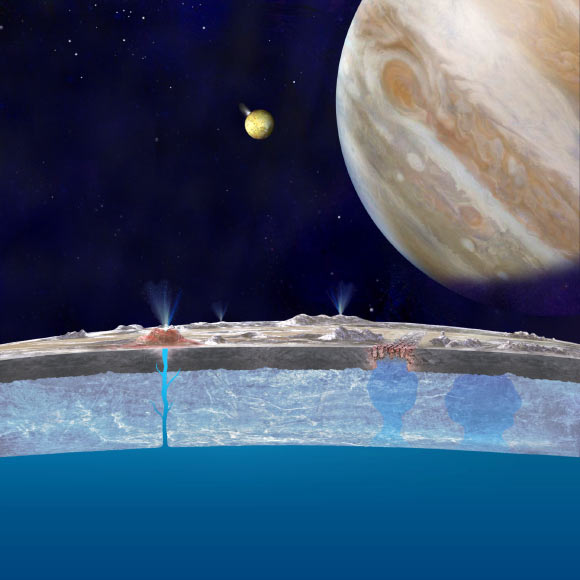Astronomers Directly Detect Water Vapor on Europa for First Time | Astronomy – Sci-News.com
Astronomers have for the first time managed to detect water vapor above the surface of Jupiter’s icy moon Europa.

Artist’s concept of ocean on Jupiter’s moon Europa. Image credit: NASA / JPL-Caltech.
Water is at the top of the list of ingredients that make life possible. It dissolves nutrients for organisms to eat, transports important chemicals within living cells, and allows those cells to get rid of waste.
Planetary scientists have evidence that liquid water is present under the icy surface of Europa and may sometimes erupt into space in huge geysers. But no one has been able to confirm the presence of water in these plumes by directly measuring the water molecule itself.
“Essential chemical elements (carbon, hydrogen, oxygen, nitrogen, phosphorus, and sulfur) and sources of energy, two of three requirements for life, are found all over the Solar System,” said Dr. Lucas Paganini, a researcher at NASA’s Goddard Space Flight Center and American University.
“But the third — liquid water — is somewhat hard to find beyond Earth.”
“While scientists have not yet detected liquid water directly, we’ve found the next best thing: water in vapor form.”
Dr. Paganini and colleagues detected enough water releasing from Europa — about 2,360 kg/s — to fill an Olympic-size swimming pool within minutes.
Yet, the scientists also found that the water appears infrequently, at least in amounts large enough to detect from Earth.
“For me, the interesting thing about this work is not only the first direct detection of water above Europa, but also the lack thereof within the limits of our detection method,” Dr. Paganini said.
The researchers used the NIRSPEC, a near-infrared spectrograph on the 10-m Keck II telescope at W.M. Keck Observatory on Maunakea, Hawaii, that measures the chemical composition of planetary atmospheres through the infrared light they emit or absorb. Molecules such as water emit specific frequencies of infrared light as they interact with solar radiation.
They detected the faint yet distinct signal of water vapor just once throughout 17 nights of observations between 2016 and 2017.
They saw water molecules at Europa’s leading hemisphere, or the side of the moon that’s always facing in the direction of its orbit around Jupiter.
“This first direct identification of water vapor on Europa is a critical confirmation of our original detections of atomic species, and it highlights the apparent sparsity of large plumes on this icy world,” said Dr. Lorenz Roth, an astronomer and physicist at KTH Royal Institute of Technology.
The results were published online this week in the journal Nature Astronomy.
_____
L. Paganini et al. A measurement of water vapour amid a largely quiescent environment on Europa. Nat Astron, published online November 18, 2019; doi: 10.1038/s41550-019-0933-6






